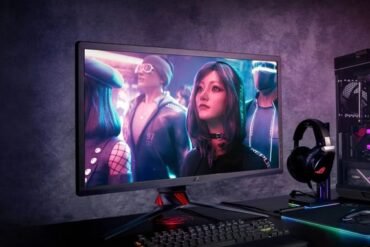RGB Lighting in PC Components: Aesthetic and Practical
Table of Contents
- The Evolution of RGB Lighting: From Basic to Spectacular
- Enhancing Gaming Experience: RGB Lighting in Keyboards and Mice
- Showcasing Style and Personality: RGB Lighting in PC Cases
- Cooling with a Twist: RGB Lighting in Fans and Liquid Cooling Systems
- Syncing the Spectrum: RGB Lighting Software and Control
The Evolution of RGB Lighting: From Basic to Spectacular
RGB lighting has become a popular trend in the world of PC components, adding both aesthetic appeal and practical functionality to computer systems. Over the years, RGB lighting has evolved from basic lighting options to more spectacular and customizable options that allow users to create unique and stunning lighting effects.
- Basic RGB Lighting: The early stages of RGB lighting in PC components involved simple color options, usually limited to a few predefined colors. Users could choose a static color or cycle through a few preset color options.
- Expanded Color Range: As technology progressed, RGB lighting systems began to offer a wider range of colors, allowing users to choose from virtually any color in the RGB spectrum. This expanded color range provided more customization options and allowed users to match their lighting with their overall system theme.
- Effects and Patterns: The next step in the evolution of RGB lighting was the introduction of effects and patterns. This allowed users to create dynamic lighting displays, such as color fading, breathing effects, and even synchronized lighting with music or game events. These effects added a new level of immersion and personalization to PC builds.
- Addressable RGB: The introduction of addressable RGB (ARGB) lighting brought even more flexibility and control to PC lighting systems. With ARGB, each individual LED can be controlled independently, allowing for more intricate lighting effects and patterns. This level of customization allows users to create truly unique and eye-catching lighting displays.
- Syncing and Integration: Today, RGB lighting can be synced and integrated across various PC components. This means that the lighting effects on the motherboard, graphics card, RAM, and other components can be coordinated and controlled through a single software interface. This synchronization ensures a seamless and visually appealing lighting experience.
RGB lighting in PC components has come a long way, from basic static colors to the spectacular and customizable lighting effects we see today. With continuous advancements in technology, it is safe to say that RGB lighting will continue to evolve, offering even more stunning options for PC enthusiasts and gamers.
Enhancing Gaming Experience: RGB Lighting in Keyboards and Mice
RGB lighting has become increasingly popular in the world of PC gaming, adding a new level of aesthetic appeal and practicality to gaming components. When it comes to keyboards and mice, RGB lighting not only enhances the visual experience but also provides functional advantages for gamers.
One of the main benefits of RGB lighting in keyboards and mice is the ability to customize and personalize the gaming setup. With a wide range of colors and lighting effects to choose from, gamers can create a unique ambiance that matches their style and preferences. This adds an element of immersion to the gaming experience, making it more enjoyable and engaging.
Moreover, RGB lighting can also serve a practical purpose by providing visual cues and feedback during gameplay. Many gaming keyboards and mice allow users to assign different colors to specific keys or buttons, enabling quick and easy recognition of different functions or macros. This can be particularly useful in fast-paced games where split-second reactions are crucial.
Additionally, RGB lighting can be synchronized with other PC components such as monitors, fans, and even the computer case itself. This creates a cohesive and visually stunning gaming setup, immersing players in a fully customizable environment. The ability to match the lighting effects to in-game events or music adds an extra layer of immersion, enhancing the overall gaming experience.
Furthermore, some keyboards and mice with RGB lighting also offer software integration, allowing users to create complex lighting profiles and effects. This opens up a world of possibilities for gamers to experiment and create unique lighting setups that reflect their individuality.
- RGB lighting adds an aesthetic appeal to gaming setups, making them visually striking and immersive.
- Customizable lighting effects provide a personal touch, matching the gamer’s style and preferences.
- Visual cues and feedback through RGB lighting help improve gaming performance and reaction times.
- Synchronization with other PC components creates a cohesive and visually stunning gaming experience.
- Software integration allows for complex lighting profiles and effects, enabling gamers to showcase their creativity.
In conclusion, RGB lighting in keyboards and mice goes beyond mere aesthetics, offering practical advantages that enhance the overall gaming experience. From personalization to improved functionality, RGB lighting has become an essential feature for gamers looking to create a visually stunning and immersive gaming setup.
Showcasing Style and Personality: RGB Lighting in PC Cases
RGB lighting has become increasingly popular in the world of PC building, allowing enthusiasts to showcase their unique style and personality. PC cases equipped with RGB lighting not only add a touch of aesthetics to the overall setup but also offer practical benefits. Let’s explore how RGB lighting enhances the visual appeal and functionality of PC cases.
1. Aesthetic Appeal: RGB lighting provides an opportunity to create stunning visual effects within the PC case. With customizable colors and lighting patterns, users can personalize their setups to match their preferred style or mood. Whether it’s a subtle glow or a vibrant light show, RGB lighting allows PC builders to transform their cases into eye-catching masterpieces.
2. Enhanced Gaming Experience: RGB lighting in PC cases can elevate the gaming experience by creating an immersive atmosphere. Syncing the lighting effects with in-game actions or music amplifies the excitement and adds an extra layer of immersion. Many gaming peripherals and components also support RGB lighting, allowing users to synchronize the colors throughout their entire setup.
3. Improved Visibility and Functionality: RGB lighting is not just about aesthetics; it can also serve practical purposes. Many PC cases feature lighting strips or individual LEDs that can be strategically placed to enhance visibility inside the case. This makes it easier to locate components, troubleshoot issues, or make adjustments during upgrades. Additionally, some cases offer lighting that indicates system temperatures or fan speeds, providing real-time feedback at a glance.
4. Customization and Control: PC cases with RGB lighting often come with specialized software that allows users to customize and control the lighting effects. Through intuitive interfaces, users can easily adjust colors, brightness, and lighting patterns according to their preferences. Some software even offers advanced features like programmable macros or integration with popular gaming platforms, providing endless possibilities for personalization.
In conclusion, RGB lighting in PC cases is more than just a visual upgrade. It allows users to showcase their unique style, enhances the gaming experience, improves visibility and functionality, and offers extensive customization options. Whether you’re a hardcore gamer, a creative professional, or simply someone who appreciates aesthetics, RGB lighting in PC cases is a perfect way to add a touch of personality to your setup.
Cooling with a Twist: RGB Lighting in Fans and Liquid Cooling Systems
RGB lighting has become a popular trend in PC components, adding a touch of aesthetic flair to gaming setups. While it may seem like a purely cosmetic feature, RGB lighting can also serve a practical purpose when it comes to cooling systems. In this article, we will explore how RGB lighting is incorporated into fans and liquid cooling systems, and the benefits it brings.
When it comes to cooling fans, RGB lighting is integrated into the fan blades or the fan housing. These lights can be customized to display a wide range of colors and lighting patterns, allowing users to personalize their PC builds. Beyond aesthetics, RGB lighting in fans can also provide visual cues for monitoring system temperatures. For example, the lights can change color based on the temperature levels, alerting users to potential overheating issues.
Liquid cooling systems, on the other hand, take RGB lighting to a whole new level. In addition to lighting up the fans, liquid cooling systems often feature RGB lighting in the water blocks, reservoirs, and tubing. This creates a stunning visual effect as the colored liquid flows through the system. Some high-end liquid cooling systems even allow users to synchronize the lighting effects with other RGB components in their PCs, creating a harmonious light show.
But beyond the eye-catching aesthetics, RGB lighting in liquid cooling systems serves a practical purpose as well. The lighting can be programmed to indicate the coolant temperature, allowing users to quickly identify any potential cooling issues. Furthermore, RGB lighting in liquid cooling systems can also help with maintenance. By illuminating the areas where the coolant flows, users can easily spot any leaks or blockages, simplifying the troubleshooting process.
In conclusion, RGB lighting in fans and liquid cooling systems not only adds a visually appealing touch to PC builds but also offers practical benefits. From providing temperature indicators to aiding in system maintenance, RGB lighting enhances the overall cooling experience. So, whether you’re a gaming enthusiast or a PC building aficionado, consider incorporating RGB lighting into your cooling setup for both style and functionality.
Syncing the Spectrum: RGB Lighting Software and Control
RGB lighting has become an integral part of PC components, enhancing the aesthetic appeal and allowing users to personalize their setups. However, managing multiple RGB lighting components can be a challenge without proper software and control. This is where RGB lighting software and control systems come into play, providing users with the ability to synchronize and customize their RGB lighting experience.
RGB lighting software acts as a central hub, enabling users to control and manage the lighting effects of various components, such as RGB fans, RAM modules, and RGB strips, from a single interface. These software solutions often come bundled with RGB-enabled components or can be downloaded separately from the manufacturer’s website. They offer a range of features and customization options, allowing users to create stunning lighting effects, adjust colors, and even synchronize lighting patterns with music or game events.
One of the key advantages of RGB lighting software is its ability to sync the lighting effects across multiple components. This means that users can create a uniform lighting theme throughout their entire system, ensuring a visually cohesive setup. With software like Corsair iCUE, ASUS Aura Sync, or NZXT CAM, users can link their RGB fans, RAM, and other components to produce synchronized lighting patterns. This not only enhances the aesthetics but also creates a more immersive experience.
Additionally, RGB lighting software often includes pre-set lighting profiles, allowing users to quickly and easily switch between different lighting effects. These profiles can range from subtle and elegant to bold and vibrant, catering to various user preferences. Some software even provides community-driven profiles that users can download and apply, further expanding the range of lighting options available.
Furthermore, RGB lighting control systems provide users with the flexibility to adjust and fine-tune their RGB lighting setups. These control systems, such as the Corsair Lighting Node Pro or the NZXT Hue 2, offer additional hardware components that enable users to extend and expand their RGB lighting capabilities. These systems can connect to multiple RGB components, allowing for precise control over individual lights or groups of lights.
- RGB lighting software acts as a central hub for managing and controlling RGB lighting effects.
- Software solutions enable synchronization of RGB lighting across multiple components.
- Pre-set lighting profiles provide quick and easy customization options.
- RGB lighting control systems offer additional hardware for fine-tuning lighting setups.
In conclusion, RGB lighting software and control systems play a crucial role in managing and customizing the RGB lighting experience in PC components. They offer users the ability to synchronize lighting effects, create personalized lighting themes, and adjust lighting setups to their preferences. With the wide range of software and control options available, users can truly unlock the full potential of RGB lighting in their PC setups.


























